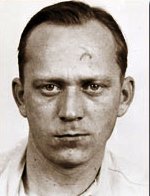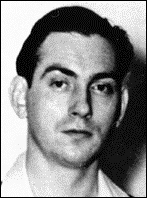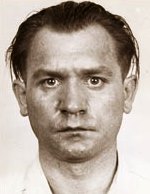Operation Pastorius
| Operation Pastorius | |
|---|---|
| Part of the American Theater of World War II | |
 The trial of the captured Germans, July 1942. | |
| Objective | Sabotage American economic infrastructure |
| Date | June 1942 |
| Executed by | Nazi Germany |
| Outcome | Failed |
Operation Pastorius was a failed German intelligence plan for sabotage inside the United States during World War II. The operation was staged in June 1942 and was to be directed against strategic American economic targets. The operation was named by Admiral Wilhelm Canaris, chief of the German Abwehr, for Francis Daniel Pastorius, the leader of the first organized settlement of Germans in America.
Background[]
After the Japanese attack on Pearl Harbor on 7 December 1941, followed by Nazi Germany's declaration of war on the United States four days later,[1] and the United States' declaration of war on Germany in response, Hitler authorized a mission to sabotage the American war effort and attack civilian targets to demoralize the American civilian population inside the United States.[2] The mission was headed by Admiral Wilhelm Canaris, chief of the German Abwehr. Canaris recalled that during World War I, he organized the sabotage of French installations in Morocco, and that other German agents entered the United States to plant bombs in New York arms factories, including the destruction of munitions supplies at Black Tom Island, in 1916. He hoped that Operation Pastorius would have the same kind of success they had in 1916.[3]
Agents[]
Recruited for Operation Pastorius were eight German residents who had lived in the United States. Two of them, Ernst Burger and Herbert Haupt, were American citizens. The others, George John Dasch, Edward John Kerling, Richard Quirin, Heinrich Harm Heinck, Hermann Otto Neubauer, and Werner Thiel, had worked at various jobs in the United States. All eight were recruited into the Abwehr military intelligence organization and were given three weeks of intensive sabotage training in the German High Command school on an estate at Quenz Lake, near Berlin, Germany. The agents were instructed in the manufacture and use of explosives, incendiaries, primers, and various forms of mechanical, chemical, and electrical delayed timing devices. Considerable time was spent developing complete background "histories" they were to use in the United States. They were encouraged to converse in English and to read American newspapers and magazines to hone their English and familiarity with current American events and culture.[4]
Mission[]
Their mission was to stage sabotage attacks on American economic targets: hydroelectric plants at Niagara Falls; the Aluminum Company of America's plants in Illinois, Tennessee, and New York; locks on the Ohio River near Louisville, Kentucky; Penn Salt Factory in Bensalem, Pennsylvania;[5] the Horseshoe Curve, a crucial railroad pass near Altoona, Pennsylvania, as well as the Pennsylvania Railroad's repair shops at Altoona;[6] a cryolite plant in Philadelphia; Hell Gate Bridge in New York; and Pennsylvania Station in Newark, New Jersey. The agents were also instructed to spread a wave of terror by planting explosives on bridges, railroad stations, water facilities, and public places. They were given counterfeit birth certificates, Social Security Cards, draft deferment cards, nearly $175,000 in American money, and driver's licenses, and put aboard two U-boats to land on the east coast of the U.S.[4]
Before the mission began, it was in danger of being compromised, as George Dasch, head of the team, left sensitive documents behind on a train, and one of the agents when drunk announced to patrons at a bar in Paris that he was a secret agent.[7]
On the night of 12 June 1942, the first submarine to arrive in the U.S., U-202,[8] landed at Amagansett, New York, which is about 100 miles east of New York City, on Long Island, at what today is Atlantic Avenue beach. It was carrying Dasch and three other saboteurs (Burger, Quirin, and Heinck). The team came ashore wearing German Navy uniforms so that if they were captured, they would be classified as prisoners of war rather than spies.[9][10] They also brought their explosives, primers and incendiaries, and buried them along with their uniforms, and put on civilian clothes to begin an expected two-year campaign in the sabotage of American defense-related production.[11]
When Dasch was discovered amidst the dunes by unarmed Coast Guardsman John C. Cullen, Dasch offered Cullen a $260 bribe.[12] Cullen feigned cooperation but reported the encounter. An armed patrol returned to the site but found only the buried equipment; the Germans had taken the Long Island Rail Road from the Amagansett station into Manhattan, where they checked into a hotel. A massive manhunt was begun.
The other four-member German team headed by Kerling landed without incident at Ponte Vedra Beach, Florida, south of Jacksonville on 16 June 1942. They came on U-584, another submarine.[13] This group came ashore wearing bathing suits but wore German Navy hats. After landing ashore, they threw away their hats, put on civilian clothes, and started their mission by boarding trains to Chicago, Illinois and Cincinnati, Ohio.[10]
The two teams were to meet on 4 July in a hotel in Cincinnati to coordinate their sabotage operations.[14]
Betrayal[]
Dasch called Burger into their upper-story hotel room and opened a window, saying they would talk, and if they disagreed, "only one of us will walk out that door—the other will fly out this window." Dasch told him he had no intention of going through with the mission, hated Nazism, and planned to report the plot to the FBI. Burger agreed to defect to the United States immediately.[15][16]
On 15 June, Dasch phoned the New York office of the FBI to explain who he was, but hung up when the agent answering doubted his story. Four days later, he took a train to Washington, DC and walked into FBI headquarters, where he gained the attention of Assistant Director D. M. Ladd by showing him the operation's budget of $84,000 cash.[16][17] Besides Burger, none of the other German agents knew they were betrayed. Over the next two weeks, Burger and the other six were arrested. FBI Director J. Edgar Hoover made no mention that Dasch had turned himself in, and claimed credit for the FBI for cracking the spy ring.[18]
Mugshots[]

Ernst Peter Burger



Trial and execution[]
Fearful that a civilian court would be too lenient, President Roosevelt issued Executive Proclamation 2561 on 2 July 1942 creating a military tribunal[19] to prosecute the Germans.[20] Placed before a seven-member military commission, the Germans were charged with the following offenses:
- Violating the law of war;
- Violating Article 81 of the Articles of War, defining the offense of corresponding with or giving intelligence to the enemy;
- Violating Article 82 of the Articles of War, defining the offense of spying; and
- Conspiracy to commit the offenses alleged in the first three charges.
The trial was held in Assembly Hall #1 on the fifth floor of the Department of Justice building in Washington D.C. on 8 July 1942.[21] Lawyers for the accused, who included Lauson Stone and Kenneth Royall, attempted to have the case tried in a civilian court but were rebuffed by the United States Supreme Court in Ex parte Quirin, 317 U.S. 1 (1942), a case that was later cited as a precedent for the trial by military commission of any unlawful combatant against the United States.
The trial for the eight defendants ended on 1 August 1942. Two days later, all were found guilty and sentenced to death. Roosevelt commuted Burger's sentence to life in prison and Dasch's to 30 years because they had turned themselves in and provided information about the others. The others were executed on 8 August 1942 in the electric chair on the third floor of the District of Columbia jail and buried in a potter's field in the Blue Plains neighborhood in the Anacostia area of Washington.
Aftermath[]
The failure of Operation Pastorius led Hitler to rebuke Admiral Canaris and no sabotage attempt was ever made again in the United States. During the remaining years of the war, the Germans only once more dispatched agents to the United States by submarine. In November 1944, as part of Operation Elster, the German submarine U-1230 dropped two RSHA spies off the coast of Maine to gather intelligence on American manufacturing and technical progress. The FBI captured both men shortly after.[22] These agents benefited from the calmer state of public nerves in the later years of the war and received prison sentences rather than execution.[23]
In 1948, President Harry S. Truman granted executive clemency to Dasch and Burger on the condition that they be deported to the American Zone of occupied Germany. They were not welcomed back in Germany, as they were regarded as traitors who had caused the death of their comrades.[24] Although they had been promised pardons by Hoover in exchange for their cooperation, both men died without ever receiving them.[further explanation needed] Dasch died in 1992 at the age of 89 in Ludwigshafen, Germany. Burger died in 1975.
Sometime in the 1960s or 1970s, the National Socialist White People's Party placed an unauthorized monument to the executed spies in a thicket in southwest Washington, D.C. on National Park Service land. It went largely unknown and ignored for several decades; the Park Service removed it in 2010.[18]
See also[]
- Duquesne Spy Ring
- They Came to Blow Up America, a 1943 film based on Operation Pastorius, starring George Sanders
- Saboteur, a 1942 film revolving around acts of sabotage on the U.S. mainland during World War II
- New York at War, military parade held at same time
References[]
Notes
- ^ "Germany declares war on the United States - Dec 11, 1941 - HISTORY.com". Retrieved 30 December 2016.
- ^ Alex Abella, Scott Gordon (January 2003). Shadow Enemies: Hitler's Secret Terrorist Plot Against the United States. The Lyons Press. p. 17. ISBN 1-5857-4722-X.
- ^ John Craig (2 February 2004). Peculiar Liaisons in War, Espionage, and Terrorism of the Twentieth Century. Algora Publishing. p. 170. ISBN 0-8758-6331-0.
- ^ Jump up to: a b Francis MacDonnell (2 November 1995). Insidious Foes: The Axis Fifth Column and the American Home Front. Oxford University Press. p. 131. ISBN 0-1950-9268-6.
- ^ LaVOCorrespondent, Carl. "LaVO: Bensalem factory targeted for destruction in World War II". Bucks County Courier Times. Retrieved 22 November 2020.
- ^ Horseshoe Curve, NRHS - Railfan's Guide to the Altoona Area(Requires Java 1.6 as of 1 January 2009]
- ^ Dobbs, Michael (February 2004). Saboteurs: The Nazi Raid on America. Knopf. ISBN 978-0-375-41470-1.
- ^ "The Type VIIC boat U-202 - German U-boats of WWII - uboat.net". Retrieved 30 December 2016.
- ^ Judicial Review for Enemy Fighters: The Court’s Fateful Turn in Ex parte Quirin, the Nazi Saboteur Case Archived 3 December 2013 at the Wayback Machine
- ^ Jump up to: a b Noah Feldman (8 November 2010). Scorpions: The Battles and Triumphs of FDR's Great Supreme Court Justices. Hachette Book Group USA. p. 186. ISBN 978-0-4465-8057-1. Retrieved 25 July 2013.
- ^ Federal Bureau of Investigation: George John Dasch and the Nazi Saboteurs, FBI Famous Cases
- ^ Elke Frenzel, Hitler's Unfulfilled Dream of a New York in Flames Der Spiegel 16 September 2010
- ^ "The Type VIIC boat U-584 - German U-boats of WWII - uboat.net". Retrieved 30 December 2016.
- ^ Page 130, The Florida Historical Quarterly, Volume 49
- ^ Joseph T. McCann (2006). Terrorism on American Soil: A Concise History of Plots and Perpetrators from the Famous to the Forgotten. Sentient Publications. pp. 81–. ISBN 978-1-59181-049-0.
- ^ Jump up to: a b Michael Dobbs (18 December 2007). Saboteurs: The Nazi Raid on America. Knopf Doubleday Publishing Group. p. 119. ISBN 978-0-307-42755-7.
- ^ Richard Goldstein (13 April 2010). Helluva Town: The Story of New York City During World War II. Free Press. p. 40. ISBN 978-1-4165-8996-9.
- ^ Jump up to: a b Cox, John Woodrow (23 June 2017). "Six Nazi spies were executed in D.C. White supremacists gave them a memorial – on federal land". The Washington Post. Retrieved 23 June 2017.
- ^ "Franklin D. Roosevelt: Proclamation 2561—Denying Certain Enemies Access to the Courts". Retrieved 30 December 2016.
- ^ Jessie-Lynne Kerr (12 July 2010). "A Look Back: Nazi agents picked Ponte Vedra as landing point in 1942". The Florida Times-Union.
- ^ Joseph E. Persico (22 October 2002). Roosevelt's Secret War: FDR and World War II Espionage. Random House. p. 204. ISBN 0-3757-6126-8.
- ^ Robert A. Miller (27 February 2013). A True Story of An American Nazi Spy: William Curtis Colepaugh. Trafford Publishing. p. 73. ISBN 978-1-4669-8219-2.
- ^ Francis MacDonnell (2 November 1995). Insidious Foes: The Axis Fifth Column and the American Home Front. Oxford University Press. p. 133. ISBN 0-1950-9268-6.
- ^ "Shoot or hang themselves?". Der Spiegel (in German) (15). 6 April 1998.
Bibliography
| External video | |
|---|---|
- Dobbs, Michael, Saboteurs: The Nazi Raid on America, New York: Knopf, 2004. ISBN 0-375-41470-3
- Rachlis, Eugene, They Came to Kill: The Story of Eight Nazi Saboteurs in America, New York: Random House, 1961.
- Persico, Joseph E., Roosevelt's Secret War: FDR and World War II Espionage, New York:Random House, 2001, pp. 199–205. ISBN 0-375-50246-7
- Federal Bureau of Investigation: George John Dasch and the Nazi Saboteurs
- Lippmann, David H., World War II Plus 55, June 10-13th, 1942
- Montauk Life: The Night of the Nazis
- Cornell University School of Law: Ex Parte Quirin (summary)
- Samaha, Joel, et al. (eds.), Transcript of Proceedings before the Military Commission to Try Persons Charged with Offenses against the Law of War and the Articles of War, Washington D.C., 8 to 31 July 1942, Minneapolis: University of Minnesota, 2004. [1]
- Abella, Alex & Gordon, Scott, Shadow Enemies: Hitler's Secret Terrorist Plot Against the United States, Guilford, CT: Lyons Press, 2002. ISBN 1-58574-722-X
Further information
- The Facts Don't Matter An hour-long This American Life radio episode (original air date 3/12/2004) about the events leading up to Ex parte Quirin
External links[]
| Wikimedia Commons has media related to Operation Pastorius. |
- Six Nazi Saboteurs Executed in Washington - Ghosts of DC history blog
- They Came to Blow Up America at IMDb - a 1943 film about saboteurs, led by a German-American, landing on Long Island
- Richard Goldstein (2 September 2011). "John Cullen, Coast Guardsman Who Detected Spies, Dies at 90". The New York Times.
- 1942 in the United States
- World War II espionage
- Economic warfare
- United States military law
- Abwehr operations
- Military operations of World War II involving Germany
- American Theater of World War II
- 1942 in New York (state)
- 1942 in Florida
- 1942 in Washington, D.C.
- Germany–United States relations
- June 1942 events








